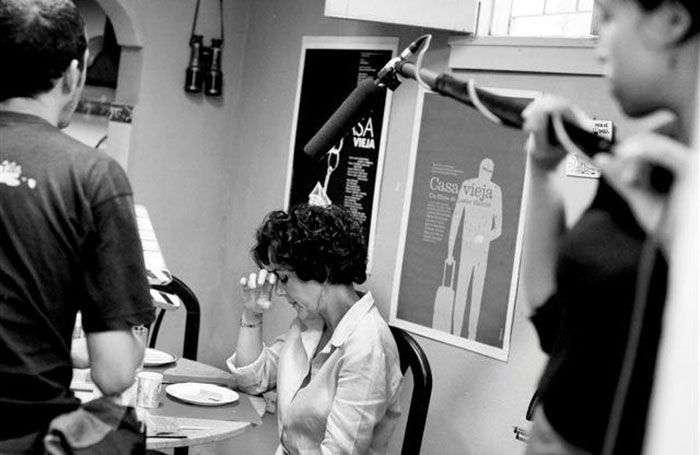Renowned producer Magda González Grau will son premier her first full-length fiction film entitled ¿Por qué lloran mis amigas? (Why do my friends cry?). The film deals with social women’s conflicts, which has been a recurrent topic in her work, mostly in the television. OnCuba met with her to talk about the challenge it presupposes to be a woman and a filmmaker in Cuba and, of course, to talk about the film, still in postproduction.
Why did you choose a women story for your first full-length fiction?
I didn’t actually choose the story, it got to me just as almost all my works. Scriptwriters like my work and they come to me to offer me the direction of their pieces. By taking a retrospective look to my work, you can realize that women issues or women characters are frequent, but I think that’s ok because I am a woman, right?
Once, while talking about women in audiovisual production I said every human being is the books he has read, the films he has seen, the experiences he has lived; soby being a woman one is closer to and is more concerned about women’s issues. It is more so if there is a trend to make gender issues more visible in audiovisuals, so you feel responsible for portraying women’s issues.
What can you tell us about the work with young scriptwriter when tackling issues of women your age?
Hannah Imbert wrote the script. She is a smart and sensitive young girl. She found her inspiration in her mother and friends, in the book “Tratado de culinaria para mujeres tristes” by Héctor Abad, and in a painting by Sandra Dooley entitled “Amigas”, which was used in the main set of the film. Hannah designed the characters and the situations and we enriched the dialogues and scenes through debates I like to arrange with the authors and the actors.
It was easy because Hannah is also the producer of the film and she participated in those workshops. We discussed ideas and then she would translate them into texts and actions. As to her age, I don’t think that’s an obstacle for intergenerational understanding. Hannah wrote the script with a lot of knowledge on the matter, knowledge that was not the result of experience but of research and intentional observation. Those of us who did have certain experience with menopause, children, long and monotonous marriage, impoverishment of values with the special period, intolerance and prejudices as to homosexuality and other topics tackled in the film, just enriched her proposal with details.
Did you made some contributions to the story from your own experiences?
I already told you every woman that worked in the film contributed with their personal experiences to finish the characters and the situations Hannah proposed. If there is a particular element of my life present in the film, then that’s Yara. I know Hannah, who used to be my daughter in law for many years, admires my determination to continue fighting for the things I believe in and she may have also taken a few elements of my anguish, that of many Cuban women trying to succeed as social and professional beings and fulfill the roles society has imposed on us as wives and mothers.
Let’s talk about the four main characters and the four actresses that interpreted them. What were the criteria you followed for choosing the casting?
They are four very different characters, with lots of things that put them apart and at the same time many things that bring them together, mostly friendship and the memories of a time when being in a boardingschool made them all equal. Their lives moved through difficult roads and the meet again after 20 years to look back at their frustrations and joys.
This dramatic structure has been very much used but it definitely works in this kind of collective stories. The casting was hard. The film was based on the stories and the performances so I needed really good and really talented actresses. I already had two, Amarilys Núñez and Luisa María Jiménez, whom I had recruited while working on “Añejo cinco siglos”, but I still had two actresses missing.
Many of the actresses I thought about were already working in other projects or traveling or were not moved by the story. My assistant director, Geraldine Leon, supported me a lot and she came up with the proposal of Edith Massola. I was astonished because I have always wanted to work with her and one just forgets about her because of her leading performance in other areas. I immediately agreed.
In the case of Yasmin Gomez I didn’t associate her with none of the characters, but as she is an excellent actress and I know she is very intelligent and very professional, I thought we would have to work hard but we would definitely succeed.
I am pleased with their work. I learned a lot during the construction of the characters. They are very professional actresses and they engaged with the characters they interpreted; they studied a lot and they made very valuable proposals for the film and had an active participation in the external design of their characters and worked really hard with specialists such as Miguel Filloy, who was in charge of hairdressing and make up, and with Tomás Piard and Rafa, who collaborated in art direction and dress design respectively.
The title spots crying and suffering, which are the essential conflicts in the plot?
If I tell you that I will be telling you the whole story, but they are four women in a difficult age, half way in their lives. They make a balance of their experiences and what they have left to live and arestill strong but not enough to change things because their past prevents them from undertaking new challenges.
In your career as producer it is possible to perceive a concern on women’s social conflicts. Would you say you are a filmmaker committed with your time and space?
How can I not be committed with my time and space? Any artist who thinks any different is not an artist. In the history of arts, even artists who characterized by evading reality, were actually reacting to that. Any artist that denies the reality is committing a lese-majesty crime because artists rely on the best tools to raise awareness in human beings and there isn’t a more powerful weapon than audiovisuals.
Then, how to reach the audience by means of emotions to cause a reflection and thenwaste it? That’s why I choose stories with meaning for my contemporaries, whether about women or not, but obviously women’s stories suit me better.
What’s the meaning of being a woman and a filmmaker in Cuba today?
I don’t think it is still hard to make movies for some of us, like some of my colleagues think. It is true there have been and there are prejudices not just for female directors but also for photographers, sound technicians, editors, producers. But that’s not absolute today, because the decision is not in the hands of officials in the traditional industries thanks to the diversification and democratization of the work force. Films are produced by those interested. And if you know how to do it right it is certain you will continue producing films. I think women have had positive results with their works.
Are you pleased with your work?
Not at all. I am a harsh critic of everything I do. When I take a seat in editing I can watch everything I did wrong and I feel guilty with the people I made accomplice of my mistakes. I try to learn from to not to repeat them. The film demanded photography by Roberto Otero, Daphne Guisado achieved really good sounds, Celia Suárez did a wonderful editing job, they all did a really good job, but there are scenes I would like to shoot differently and that’s good because it means you are alive and you never stop learning and developing. However, I hope people like the film because it tackles issues many people can relate to and it relies on many good performances.
Will the film be premiered in this edition of the New Latin American Film Festival?
I guess yes, as long as the committee accepts it. Now we are working on the music, which is in charge of Juan Antonio Leyva and Magda Rosa Galbán and the soundtrack by Osmany Olivares. We still have to work on the presentation design, the credits and other small details that would put an end to the film that’s got to be perfect.










